Related Research Articles

Townsville Post Office is a heritage-listed former post office and now brewery at 252–270 Flinders Street, Townsville CBD, City of Townsville, Queensland, Australia. It was designed by John James Clark and built in 1886 by Dennis Kellcher. It was added to the Queensland Heritage Register on 30 May 2003.
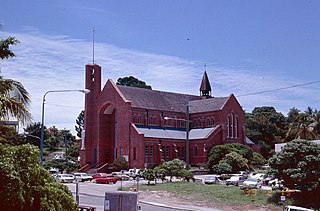
St James Cathedral is a heritage-listed cathedral of the Anglican Diocese of North Queensland at 36 Cleveland Terrace, Townsville, City of Townsville, Queensland, Australia. It was designed by Arthur Blacket and was built in 1887 by MacMahon & Cliffe. It was added to the Queensland Heritage Register on 21 October 1992.
John Beauchamp Nicholson was an architect in Brisbane, Queensland, Australia. A number of his works are heritage-listed.
Eaton & Bates was an architectural partnership in Queensland, Australia which built up a substantial Queensland practice from c. 1894-c. 1908. From 1901, it was known as Eaton, Bates & Polin. Many of their works are now heritage-listed.
Albert Edmund Bates (1862—1929) was an Australian architect. Many of his works are notable; some are heritage-listed.

World War I Cenotaph is a heritage-listed memorial at Jubilee Park, Alfred Street, Mackay, Mackay Region, Queensland, Australia. It was designed by Stephen Harvey and built from 1928 to 1929 by Melrose & Fenwick. It is also known as Mackay War Memorial and Jubilee Park. It was added to the Queensland Heritage Register on 21 August 1992.

Townsville State Government Offices is a heritage-listed office building at 12-14 Wickham Street, Townsville CBD, City of Townsville, Queensland, Australia. It was designed by Andrew Baxter Leven and built from 1935 to 1937 by relief workers. It is also known as Lands Department and Townsville Public Offices. It was added to the Queensland Heritage Register on 13 January 1995.
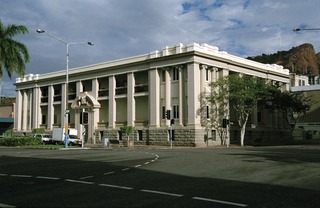
Townsville State Government Offices is a heritage-listed office building at 419 Flinders Street, Townsville CBD, City of Townsville, Queensland, Australia. It was designed by Andrew Baxter Leven and built in 1928 by Queensland Department of Public Works. It is also known as the former Public Curator's Office. It was added to the Queensland Heritage Register on 13 January 1995.
Tunbridge & Tunbridge is an architectural partnership in Townsville, Queensland, Australia. It consisted of Walter Howard Tunbridge and his brother Oliver Tunbridge. A number of their works are now heritage-listed.
W G Smith & Sons was an architecture firm headquartered in Townsville, Queensland, Australia. Some of their works are heritage-listed.

Queensland National Bank is a heritage-listed former bank at 295-303 Flinders Street, Townsville CBD, City of Townsville, Queensland, Australia. It was designed by Francis Drummond Greville Stanley and built from 1878-1879 by C A Ward. It was added to the Queensland Heritage Register on 28 January 1994.
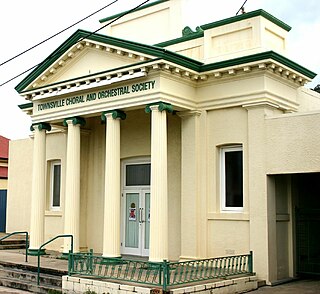
Townsville Masonic Hall is a heritage-listed former masonic temple at 485-493 Sturt Street, Townsville CBD, City of Townsville, Queensland, Australia. It was designed by W G Smith & Sons and built in 1889 by Sparre & Hansen. It is also known as Assembly of God Hall, Calvary Temple, Townsville Choral & Orchestral Society Building, Townsville Choral Society Inc. Building, and Townsville Choral and Orchestral Society Building. It was added to the Queensland Heritage Register on 21 October 1992.
Rooney Brothers was an architecture and constructions business operated by brothers John, Jacob and Matthew Rooney in Queensland, Australia. They dominated the North Queensland building industry until the early years of the 20th century.

Melrose & Fenwick were a monumental masonry firm in Townsville, Queensland, Australia. They are known for the many Queensland war memorials that they produced.

Atkinson & Powell Building is a heritage-listed former pharmacy and now general commercial premises at 181-183 Flinders Street, Townsville CBD, City of Townsville, Queensland, Australia. It was designed by Willoughby Powell and built in 1887. It is also known as Matchbox Theatre. It was added to the Queensland Heritage Register on 21 October 1992.

Henlein & Co is a heritage-listed commercial building at 408-410 Flinders Street, Townsville CBD, City of Townsville, Queensland, Australia. It was designed by Eaton, Bates & Polin and built from 1901 to 1902 by Thomas Page. It was also known as Best & Less. It was added to the Queensland Heritage Register on 21 October 1992.
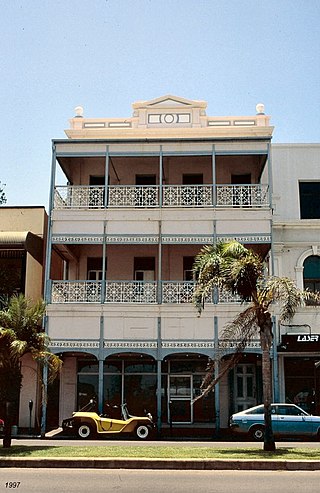
The Commercial Bank of Australia Building is a heritage-listed former bank building at 205-207 Flinders Street, Townsville CBD, City of Townsville, Queensland, Australia. It was designed by James Percy Owen Cowlishaw and built c. 1897 by J C Harrison & Sons. It is also known as the Atinee Building. It was added to the Queensland Heritage Register on 21 October 1992.
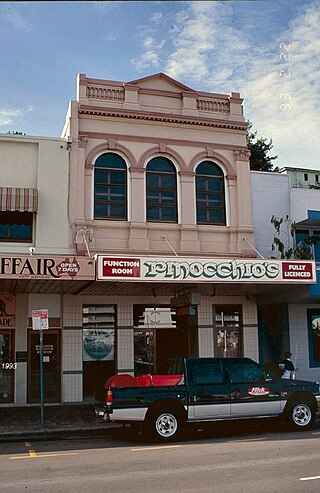
Clayton's Apothecaries' Hall is a heritage-listed pharmacy at 221-223 Flinders Street, Townsville CBD, City of Townsville, Queensland, Australia. It was built in 1885. It is also known as Bamboo Inn and Pinocchio's Restaurant. It was added to the Queensland Heritage Register on 21 October 1992.
Eyre & Munro was an architectural partnership in Townsville, Queensland, Australia. A number of their works are now heritage-listed.
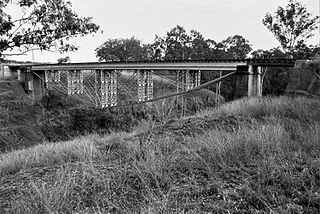
Ideraway Creek Railway Bridge is a heritage-listed railway bridge at Mungar - Monto Line, Ideraway, North Burnett Region, Queensland, Australia. It was designed by William Pagan and built from 1906 to 1907 using day labour. It was added to the Queensland Heritage Register on 21 October 1992.
References
- ↑ "FreeBMD Entry Info". www.freebmd.org.uk. Retrieved 8 January 2016.
- 1 2 "Queensland Deaths, 1933/C1045 - Stephen Harvey". Queensland Government . Retrieved 9 January 2016.
- 1 2 3 "World War I Cenotaph and Jubilee Park (entry 600667)". Queensland Heritage Register . Queensland Heritage Council. Retrieved 1 August 2014.
- ↑ "Mr. Stephen Harvey". The Brisbane Courier . 7 March 1933. p. 13. Retrieved 9 January 2016– via National Library of Australia.
Attribution
This Wikipedia article was originally based on "The Queensland heritage register" published by the State of Queensland under CC-BY 3.0 AU licence, accessed on 7 July 2014, archived published by the State of Queensland under CC-BY 3.0 AU licence (accessed on 7 July 2014, archived on 8 October 2014). The geo-coordinates were originally computed from the "Queensland heritage register boundaries" published by the State of Queensland under CC-BY 3.0 AU licence, accessed on 5 September 2014, archived published by the State of Queensland under CC-BY 3.0 AU licence (accessed on 5 September 2014, archived on 15 October 2014).